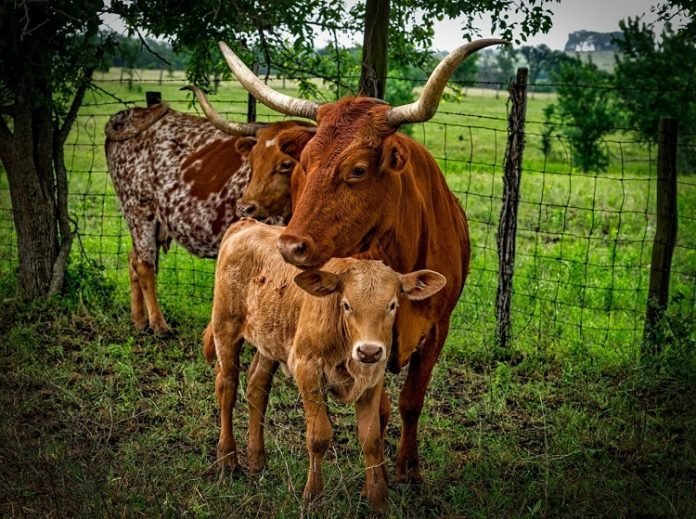Last Updated on August 8, 2025 by Rida Hamid
America grows on farmland. Ranchers use 320 million hectares of American land for livestock grazing.
Cattle ranching summons up romantic images of cowboys and fruited plains. Yet very few people know facts about ranching, let alone the basics of the ranching industry.
What are some important ranching facts? How do farmers start ranching cattle, and how do they decide where the cattle go? How important are young cattle?
Answer these questions and you can gain a rich appreciation for this all-American industry. Here are 11 facts about cattle ranching you must know.
Table of Contents
1. There Is a Cattle Cycle
The cattle cycle refers to how the size of the national cattle herd changes over time. Each cycle is different, with some taking more than a decade to complete.
In general, the size of the herd will grow before shrinking due to external conditions. Feed prices may rise, limiting the number of cattle an individual rancher can maintain. Once the prices go down, a rancher can handle more cattle.
The size can rise and fall by several million cattle. Herds are currently decreasing due to the overall economic downturn caused by COVID-19. But America still has 94.8 million cattle.
2. Calves Play Multiple Roles
Calves can be valuable in many different ways. Some calves are kept inside a ranch so the population can grow through time. But if another ranch needs cattle, the calves can be sold to them and used as breeders.
Some ranchers allow calves to grow old so they can produce meat or milk. But a rancher or slaughterhouse can kill calves to produce veal.
3. Cattle Stick Together
One reason why cattle ranching involves so many cattle is the social nature of the animals. They prefer to spend their waking hours together, and they can become distressed when they are isolated from each other.
Parents can use distinct sounds and voices to talk to their children. Many ranchers keep families together in order to avoid distress and maintain the productivity of cattle.
4. Cattle Like the Water
When people think of cattle ranches, they think about wide fields of grass. Yet cattle can swim. On a hot day, an animal will jump into the water in order to cool itself down.
When ranchers are moving cattle across a long distance, they will often take their cattle through a body of water. In addition to helping the animals cool off, the water will scare away any lingering insects.
5. Cattle Need to Lie Down
Cattle spend many hours a day lying down. Some will spend up to 12 hours lying on their stomachs.
Ranchers have to give their cattle time and space to rest. Lack of sleep can make cattle run slower and impact productivity.
6. Imports Outweigh Exports
Cattle ranching may seem like an all-American activity. Beef exports totaled 2.96 billion pounds in 2020.
But Americans imported 3.34 billion pounds that same year. Exports declined from 2019 to 2020 while imports rose. Currencies are depreciating in countries like Mexico, discouraging ranchers from shipping meat out.
7. Cattle Like Middle America
All 50 states have cattle operations. Yet 55% of beef cattle live inside the central parts of the United States.
72% of feedlots lie within Nebraska, Texas, Kansas, Iowa, and Colorado. These five states have large and flat areas where cattle can run. Their climates also support several kinds of grass and grains that cattle graze on.
8. Each Region Has Its Own Style of Ranches
Feedlots tend to have similar qualities to each other. Each lot has room for cattle to graze, walk, and rest.
But western ranchers tend to use federal lands during the spring and summer for their cattle. Ranchers in central states rely on grass pastures and private land for themselves.
9. Cattle Ranching Isn’t Just for Beef
Cattle ranchers help out with milk production in addition to beef. They can keep cattle fit and healthy before sending them to facilities where they will produce milk.
Ranchers also help with leather production. They keep cattle with thick skins alive so manufacturers can use their skin to make leather products.
10. Prices for Cattle Vary
Not all slaughter cattle are worth the same amount of money. The grading system for beef in the United States values age highly.
An animal should be old enough to have fat covering its fibers but not too old that its fibers break down. Yet the fat needs to lie inside the meat in order to be valuable. Fat elsewhere can damage fibers and produce a lower-quality product.
The heavier an animal is, the more money it tends to be worth. But cattle that have a lot of weight in their bones are less valuable. Its weight should be in its meat, skin, and fat.
11. Cattle Ranching Requires a Lot of Tools
In order to move their cattle from one location to another, ranchers rely on GPS maps. They see where sources of water are and what areas are available for their cattle to walk on.
Yet old-fashioned tools are often best. Many ranchers rely on traditional feed storage tools, including steel water troughs.
Many ranchers wear YNOT hats that block the sunlight. This lets them see for a distance and monitor the health of their cattle.
The Most Important Facts About Cattle Ranching
Cattle ranching is a complicated industry. The cattle cycle affects how many cattle are available for ranching.
Yet calves can be breeders, kept alive for milk, or killed for meat. This keeps the industry profitable.
The social nature of the animals and their love of water means ranchers have to keep cattle together and work over long distances, especially in central states. They use traditional and modern tools to move cattle, including GPS devices.
Once you know about the industry, you can learn about how to become a rancher. Read ranching guides by following our coverage.
Read More: How Family Primary Care Centers Benefit American Families?



























